Pavement Materials and UHI Effect
VerifiedAdded on 2019/10/31
|44
|11395
|212
Report
AI Summary
This extensive report investigates the role of pavement materials in the urban heat island (UHI) effect. It begins with an introduction outlining the research aims, objectives, questions, and rationale, emphasizing the need for research into cooler pavement systems, particularly in tropical regions. A comprehensive literature review examines the UHI effect, its contributing factors (urban materials, urban canyons, anthropogenic heat), and challenges in controlling urban heat. The report then details the research methodology, employing a deductive approach with a qualitative data analysis of secondary sources (books, journals, articles). The findings and analysis section presents themes on the environmental impact of cool pavements, the role of air quality and greenhouse gas emissions, the impact of asphalt materials, and the influence of green initiatives. The conclusion summarizes the findings, highlighting the significance of UHI and proposing mitigation strategies using cooler asphalt materials. Recommendations for future research focus on the thermal properties of pavement systems in tropical climates, the long-term effects of different asphalt types, and a life-cycle cost analysis of cool pavements. The report includes figures and tables illustrating the UHI effect and the impact of solar radiation.
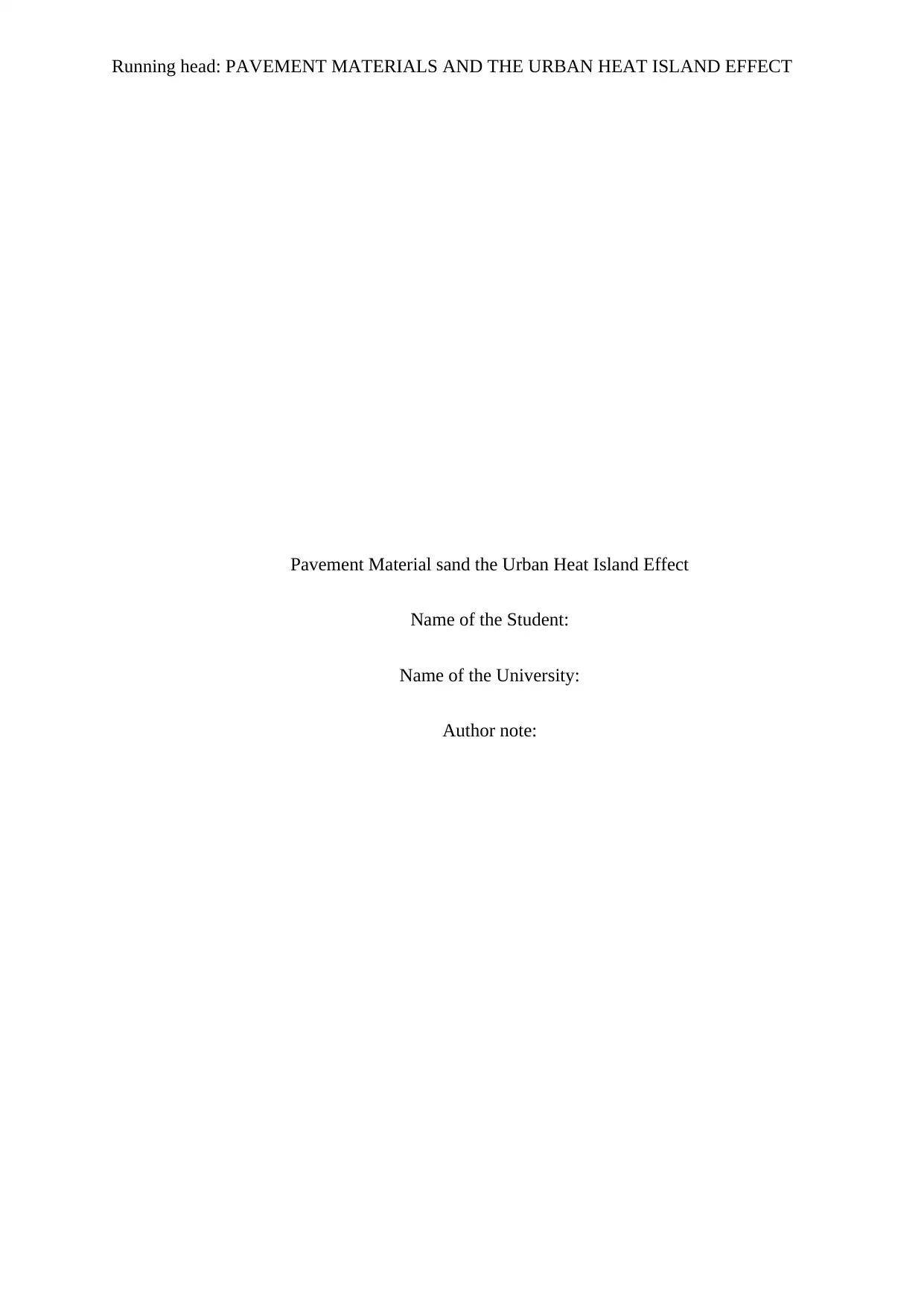
Running head: PAVEMENT MATERIALS AND THE URBAN HEAT ISLAND EFFECT
Pavement Material sand the Urban Heat Island Effect
Name of the Student:
Name of the University:
Author note:
Pavement Material sand the Urban Heat Island Effect
Name of the Student:
Name of the University:
Author note:
Paraphrase This Document
Need a fresh take? Get an instant paraphrase of this document with our AI Paraphraser
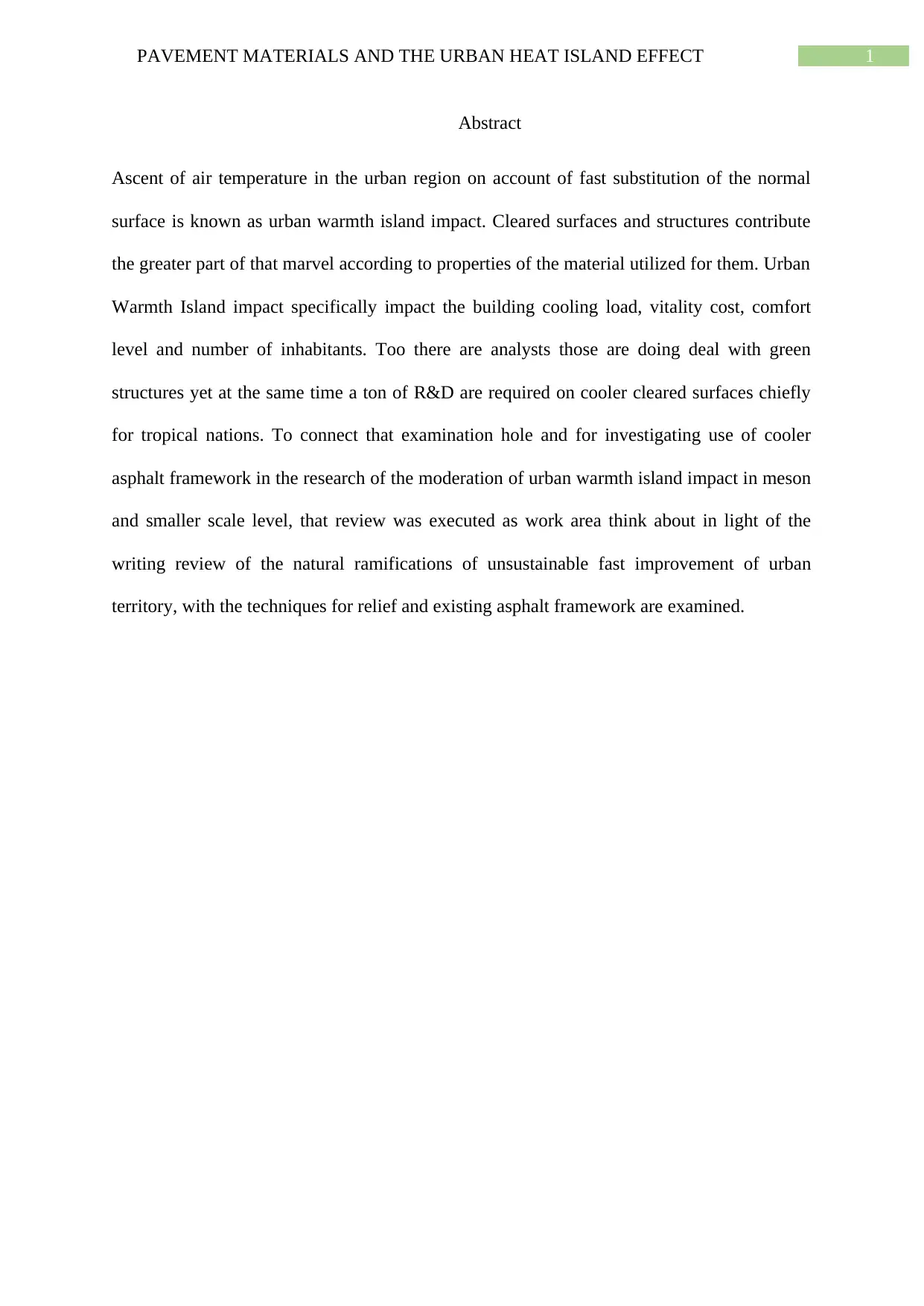
1PAVEMENT MATERIALS AND THE URBAN HEAT ISLAND EFFECT
Abstract
Ascent of air temperature in the urban region on account of fast substitution of the normal
surface is known as urban warmth island impact. Cleared surfaces and structures contribute
the greater part of that marvel according to properties of the material utilized for them. Urban
Warmth Island impact specifically impact the building cooling load, vitality cost, comfort
level and number of inhabitants. Too there are analysts those are doing deal with green
structures yet at the same time a ton of R&D are required on cooler cleared surfaces chiefly
for tropical nations. To connect that examination hole and for investigating use of cooler
asphalt framework in the research of the moderation of urban warmth island impact in meson
and smaller scale level, that review was executed as work area think about in light of the
writing review of the natural ramifications of unsustainable fast improvement of urban
territory, with the techniques for relief and existing asphalt framework are examined.
Abstract
Ascent of air temperature in the urban region on account of fast substitution of the normal
surface is known as urban warmth island impact. Cleared surfaces and structures contribute
the greater part of that marvel according to properties of the material utilized for them. Urban
Warmth Island impact specifically impact the building cooling load, vitality cost, comfort
level and number of inhabitants. Too there are analysts those are doing deal with green
structures yet at the same time a ton of R&D are required on cooler cleared surfaces chiefly
for tropical nations. To connect that examination hole and for investigating use of cooler
asphalt framework in the research of the moderation of urban warmth island impact in meson
and smaller scale level, that review was executed as work area think about in light of the
writing review of the natural ramifications of unsustainable fast improvement of urban
territory, with the techniques for relief and existing asphalt framework are examined.
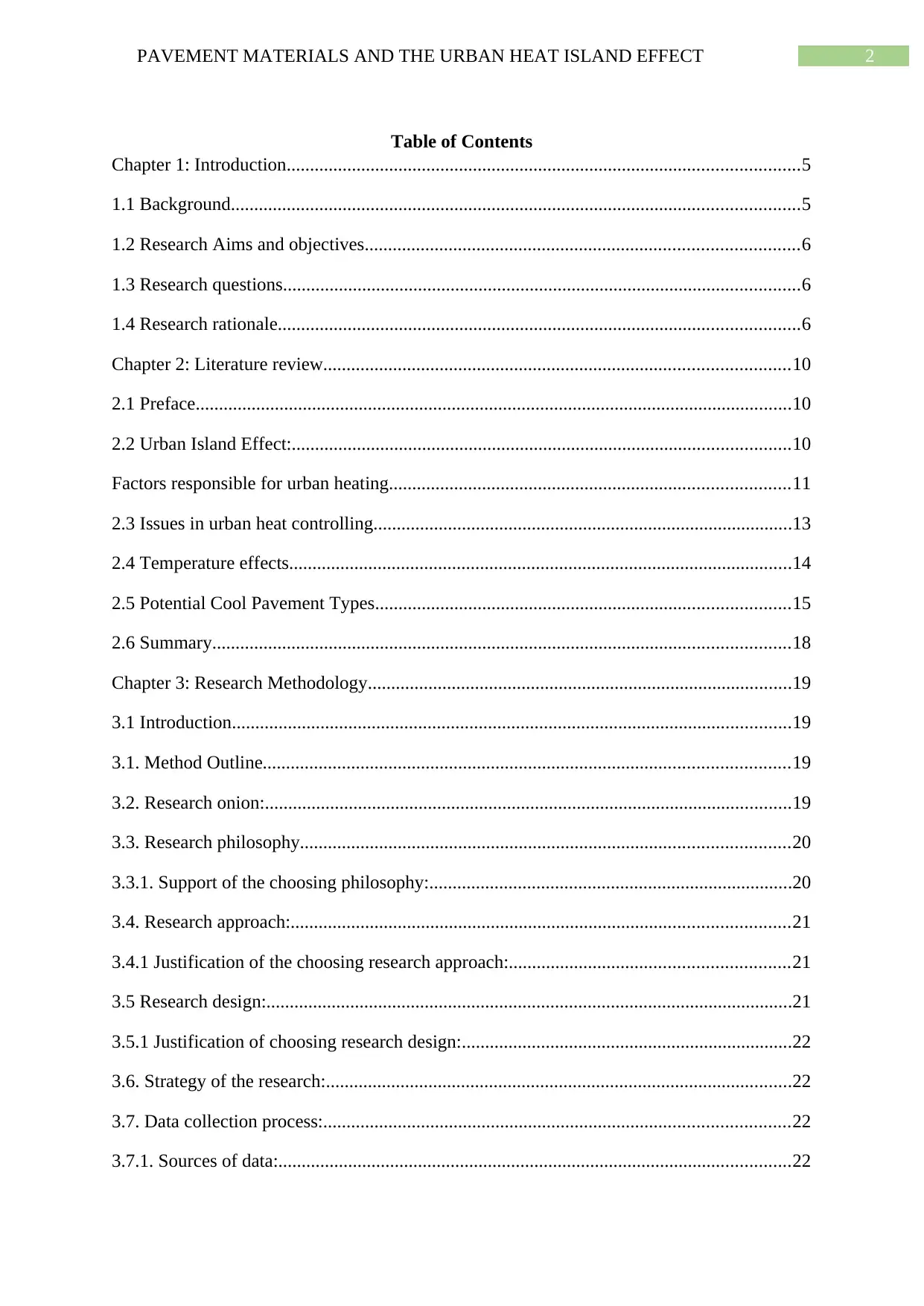
2PAVEMENT MATERIALS AND THE URBAN HEAT ISLAND EFFECT
Table of Contents
Chapter 1: Introduction..............................................................................................................5
1.1 Background..........................................................................................................................5
1.2 Research Aims and objectives.............................................................................................6
1.3 Research questions...............................................................................................................6
1.4 Research rationale................................................................................................................6
Chapter 2: Literature review....................................................................................................10
2.1 Preface................................................................................................................................10
2.2 Urban Island Effect:...........................................................................................................10
Factors responsible for urban heating......................................................................................11
2.3 Issues in urban heat controlling..........................................................................................13
2.4 Temperature effects............................................................................................................14
2.5 Potential Cool Pavement Types.........................................................................................15
2.6 Summary............................................................................................................................18
Chapter 3: Research Methodology...........................................................................................19
3.1 Introduction........................................................................................................................19
3.1. Method Outline.................................................................................................................19
3.2. Research onion:.................................................................................................................19
3.3. Research philosophy.........................................................................................................20
3.3.1. Support of the choosing philosophy:..............................................................................20
3.4. Research approach:...........................................................................................................21
3.4.1 Justification of the choosing research approach:............................................................21
3.5 Research design:.................................................................................................................21
3.5.1 Justification of choosing research design:.......................................................................22
3.6. Strategy of the research:....................................................................................................22
3.7. Data collection process:....................................................................................................22
3.7.1. Sources of data:..............................................................................................................22
Table of Contents
Chapter 1: Introduction..............................................................................................................5
1.1 Background..........................................................................................................................5
1.2 Research Aims and objectives.............................................................................................6
1.3 Research questions...............................................................................................................6
1.4 Research rationale................................................................................................................6
Chapter 2: Literature review....................................................................................................10
2.1 Preface................................................................................................................................10
2.2 Urban Island Effect:...........................................................................................................10
Factors responsible for urban heating......................................................................................11
2.3 Issues in urban heat controlling..........................................................................................13
2.4 Temperature effects............................................................................................................14
2.5 Potential Cool Pavement Types.........................................................................................15
2.6 Summary............................................................................................................................18
Chapter 3: Research Methodology...........................................................................................19
3.1 Introduction........................................................................................................................19
3.1. Method Outline.................................................................................................................19
3.2. Research onion:.................................................................................................................19
3.3. Research philosophy.........................................................................................................20
3.3.1. Support of the choosing philosophy:..............................................................................20
3.4. Research approach:...........................................................................................................21
3.4.1 Justification of the choosing research approach:............................................................21
3.5 Research design:.................................................................................................................21
3.5.1 Justification of choosing research design:.......................................................................22
3.6. Strategy of the research:....................................................................................................22
3.7. Data collection process:....................................................................................................22
3.7.1. Sources of data:..............................................................................................................22
⊘ This is a preview!⊘
Do you want full access?
Subscribe today to unlock all pages.

Trusted by 1+ million students worldwide
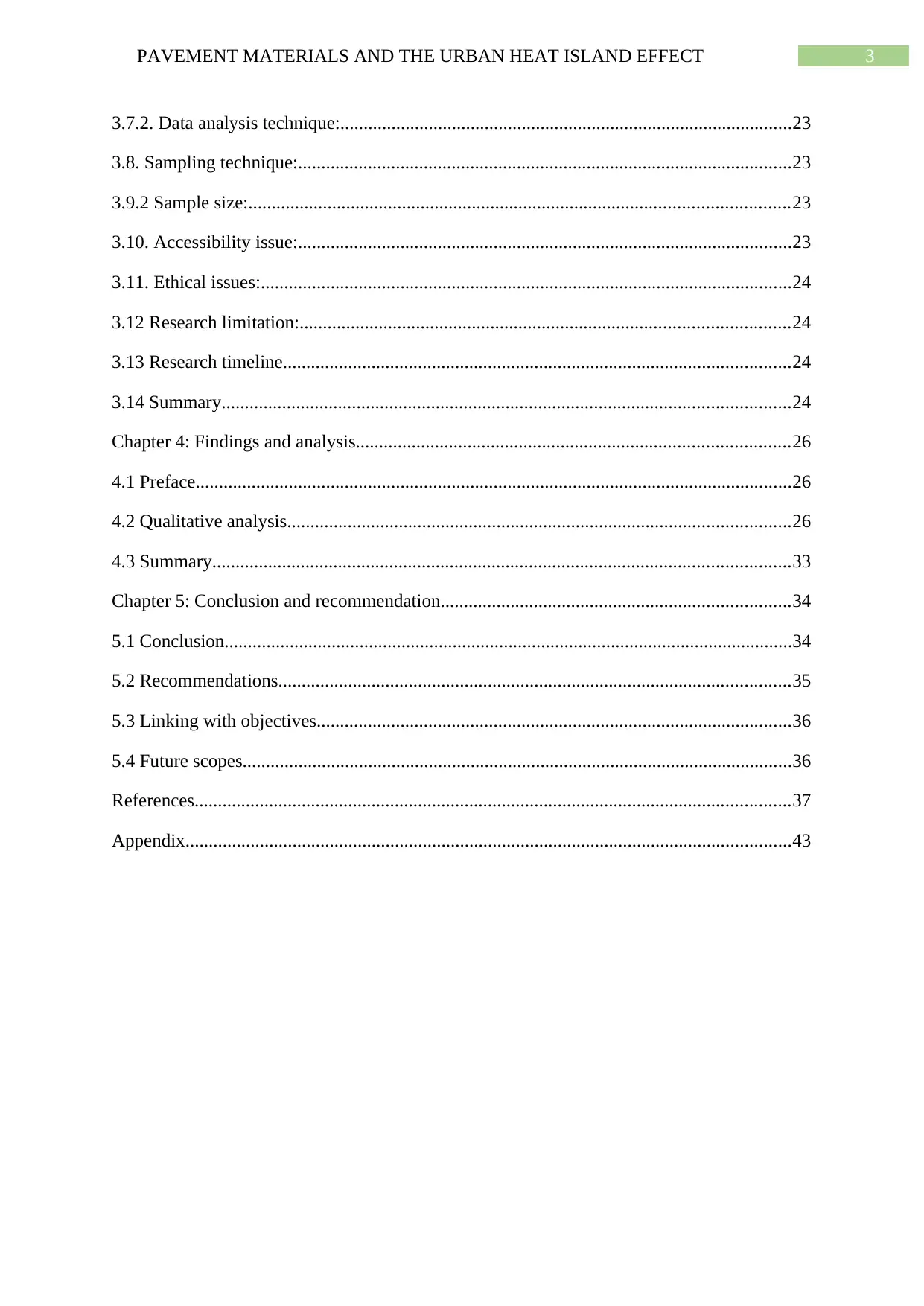
3PAVEMENT MATERIALS AND THE URBAN HEAT ISLAND EFFECT
3.7.2. Data analysis technique:.................................................................................................23
3.8. Sampling technique:..........................................................................................................23
3.9.2 Sample size:....................................................................................................................23
3.10. Accessibility issue:..........................................................................................................23
3.11. Ethical issues:..................................................................................................................24
3.12 Research limitation:.........................................................................................................24
3.13 Research timeline.............................................................................................................24
3.14 Summary..........................................................................................................................24
Chapter 4: Findings and analysis.............................................................................................26
4.1 Preface................................................................................................................................26
4.2 Qualitative analysis............................................................................................................26
4.3 Summary............................................................................................................................33
Chapter 5: Conclusion and recommendation...........................................................................34
5.1 Conclusion..........................................................................................................................34
5.2 Recommendations..............................................................................................................35
5.3 Linking with objectives......................................................................................................36
5.4 Future scopes......................................................................................................................36
References................................................................................................................................37
Appendix..................................................................................................................................43
3.7.2. Data analysis technique:.................................................................................................23
3.8. Sampling technique:..........................................................................................................23
3.9.2 Sample size:....................................................................................................................23
3.10. Accessibility issue:..........................................................................................................23
3.11. Ethical issues:..................................................................................................................24
3.12 Research limitation:.........................................................................................................24
3.13 Research timeline.............................................................................................................24
3.14 Summary..........................................................................................................................24
Chapter 4: Findings and analysis.............................................................................................26
4.1 Preface................................................................................................................................26
4.2 Qualitative analysis............................................................................................................26
4.3 Summary............................................................................................................................33
Chapter 5: Conclusion and recommendation...........................................................................34
5.1 Conclusion..........................................................................................................................34
5.2 Recommendations..............................................................................................................35
5.3 Linking with objectives......................................................................................................36
5.4 Future scopes......................................................................................................................36
References................................................................................................................................37
Appendix..................................................................................................................................43
Paraphrase This Document
Need a fresh take? Get an instant paraphrase of this document with our AI Paraphraser

4PAVEMENT MATERIALS AND THE URBAN HEAT ISLAND EFFECT
List of table and figure
Figure 1: Urban Heat Island.........................................................................................27
Figure 2: Urban heat effect..........................................................................................29
Figure 3: Solar radiation effect....................................................................................32
Table 1: Gantt chart......................................................................................................43
List of table and figure
Figure 1: Urban Heat Island.........................................................................................27
Figure 2: Urban heat effect..........................................................................................29
Figure 3: Solar radiation effect....................................................................................32
Table 1: Gantt chart......................................................................................................43
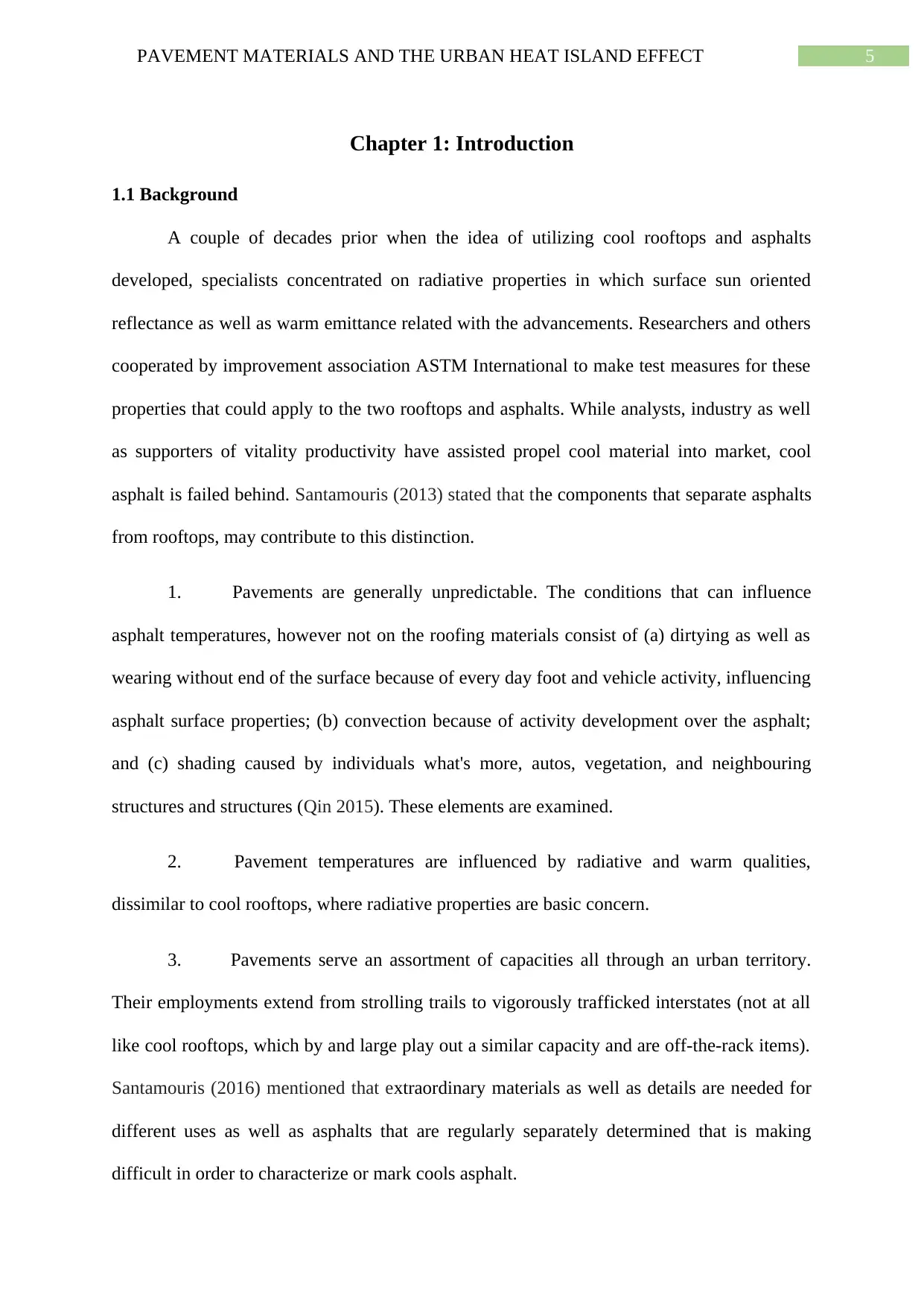
5PAVEMENT MATERIALS AND THE URBAN HEAT ISLAND EFFECT
Chapter 1: Introduction
1.1 Background
A couple of decades prior when the idea of utilizing cool rooftops and asphalts
developed, specialists concentrated on radiative properties in which surface sun oriented
reflectance as well as warm emittance related with the advancements. Researchers and others
cooperated by improvement association ASTM International to make test measures for these
properties that could apply to the two rooftops and asphalts. While analysts, industry as well
as supporters of vitality productivity have assisted propel cool material into market, cool
asphalt is failed behind. Santamouris (2013) stated that the components that separate asphalts
from rooftops, may contribute to this distinction.
1. Pavements are generally unpredictable. The conditions that can influence
asphalt temperatures, however not on the roofing materials consist of (a) dirtying as well as
wearing without end of the surface because of every day foot and vehicle activity, influencing
asphalt surface properties; (b) convection because of activity development over the asphalt;
and (c) shading caused by individuals what's more, autos, vegetation, and neighbouring
structures and structures (Qin 2015). These elements are examined.
2. Pavement temperatures are influenced by radiative and warm qualities,
dissimilar to cool rooftops, where radiative properties are basic concern.
3. Pavements serve an assortment of capacities all through an urban territory.
Their employments extend from strolling trails to vigorously trafficked interstates (not at all
like cool rooftops, which by and large play out a similar capacity and are off-the-rack items).
Santamouris (2016) mentioned that extraordinary materials as well as details are needed for
different uses as well as asphalts that are regularly separately determined that is making
difficult in order to characterize or mark cools asphalt.
Chapter 1: Introduction
1.1 Background
A couple of decades prior when the idea of utilizing cool rooftops and asphalts
developed, specialists concentrated on radiative properties in which surface sun oriented
reflectance as well as warm emittance related with the advancements. Researchers and others
cooperated by improvement association ASTM International to make test measures for these
properties that could apply to the two rooftops and asphalts. While analysts, industry as well
as supporters of vitality productivity have assisted propel cool material into market, cool
asphalt is failed behind. Santamouris (2013) stated that the components that separate asphalts
from rooftops, may contribute to this distinction.
1. Pavements are generally unpredictable. The conditions that can influence
asphalt temperatures, however not on the roofing materials consist of (a) dirtying as well as
wearing without end of the surface because of every day foot and vehicle activity, influencing
asphalt surface properties; (b) convection because of activity development over the asphalt;
and (c) shading caused by individuals what's more, autos, vegetation, and neighbouring
structures and structures (Qin 2015). These elements are examined.
2. Pavement temperatures are influenced by radiative and warm qualities,
dissimilar to cool rooftops, where radiative properties are basic concern.
3. Pavements serve an assortment of capacities all through an urban territory.
Their employments extend from strolling trails to vigorously trafficked interstates (not at all
like cool rooftops, which by and large play out a similar capacity and are off-the-rack items).
Santamouris (2016) mentioned that extraordinary materials as well as details are needed for
different uses as well as asphalts that are regularly separately determined that is making
difficult in order to characterize or mark cools asphalt.
⊘ This is a preview!⊘
Do you want full access?
Subscribe today to unlock all pages.

Trusted by 1+ million students worldwide
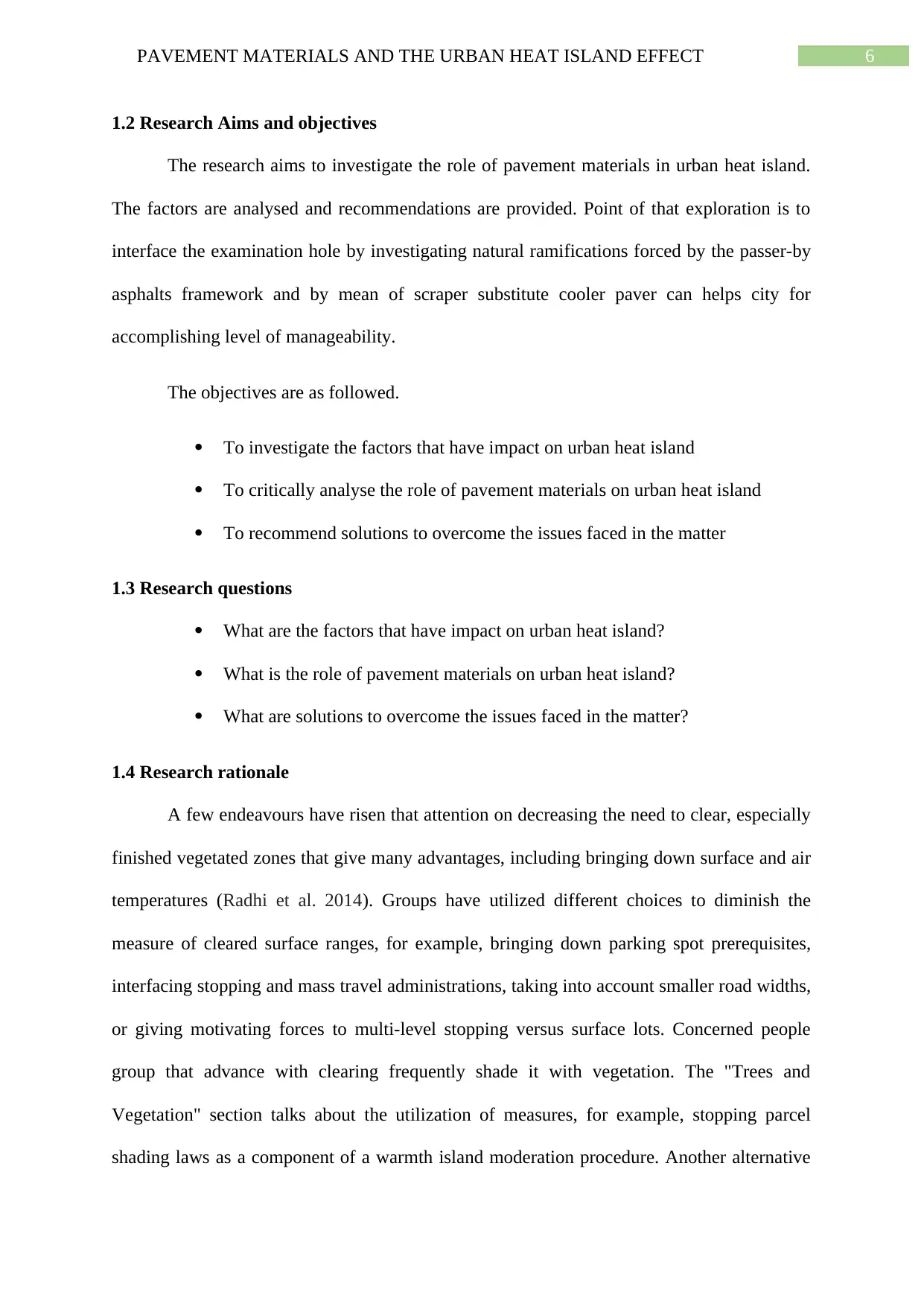
6PAVEMENT MATERIALS AND THE URBAN HEAT ISLAND EFFECT
1.2 Research Aims and objectives
The research aims to investigate the role of pavement materials in urban heat island.
The factors are analysed and recommendations are provided. Point of that exploration is to
interface the examination hole by investigating natural ramifications forced by the passer-by
asphalts framework and by mean of scraper substitute cooler paver can helps city for
accomplishing level of manageability.
The objectives are as followed.
To investigate the factors that have impact on urban heat island
To critically analyse the role of pavement materials on urban heat island
To recommend solutions to overcome the issues faced in the matter
1.3 Research questions
What are the factors that have impact on urban heat island?
What is the role of pavement materials on urban heat island?
What are solutions to overcome the issues faced in the matter?
1.4 Research rationale
A few endeavours have risen that attention on decreasing the need to clear, especially
finished vegetated zones that give many advantages, including bringing down surface and air
temperatures (Radhi et al. 2014). Groups have utilized different choices to diminish the
measure of cleared surface ranges, for example, bringing down parking spot prerequisites,
interfacing stopping and mass travel administrations, taking into account smaller road widths,
or giving motivating forces to multi-level stopping versus surface lots. Concerned people
group that advance with clearing frequently shade it with vegetation. The "Trees and
Vegetation" section talks about the utilization of measures, for example, stopping parcel
shading laws as a component of a warmth island moderation procedure. Another alternative
1.2 Research Aims and objectives
The research aims to investigate the role of pavement materials in urban heat island.
The factors are analysed and recommendations are provided. Point of that exploration is to
interface the examination hole by investigating natural ramifications forced by the passer-by
asphalts framework and by mean of scraper substitute cooler paver can helps city for
accomplishing level of manageability.
The objectives are as followed.
To investigate the factors that have impact on urban heat island
To critically analyse the role of pavement materials on urban heat island
To recommend solutions to overcome the issues faced in the matter
1.3 Research questions
What are the factors that have impact on urban heat island?
What is the role of pavement materials on urban heat island?
What are solutions to overcome the issues faced in the matter?
1.4 Research rationale
A few endeavours have risen that attention on decreasing the need to clear, especially
finished vegetated zones that give many advantages, including bringing down surface and air
temperatures (Radhi et al. 2014). Groups have utilized different choices to diminish the
measure of cleared surface ranges, for example, bringing down parking spot prerequisites,
interfacing stopping and mass travel administrations, taking into account smaller road widths,
or giving motivating forces to multi-level stopping versus surface lots. Concerned people
group that advance with clearing frequently shade it with vegetation. The "Trees and
Vegetation" section talks about the utilization of measures, for example, stopping parcel
shading laws as a component of a warmth island moderation procedure. Another alternative
Paraphrase This Document
Need a fresh take? Get an instant paraphrase of this document with our AI Paraphraser
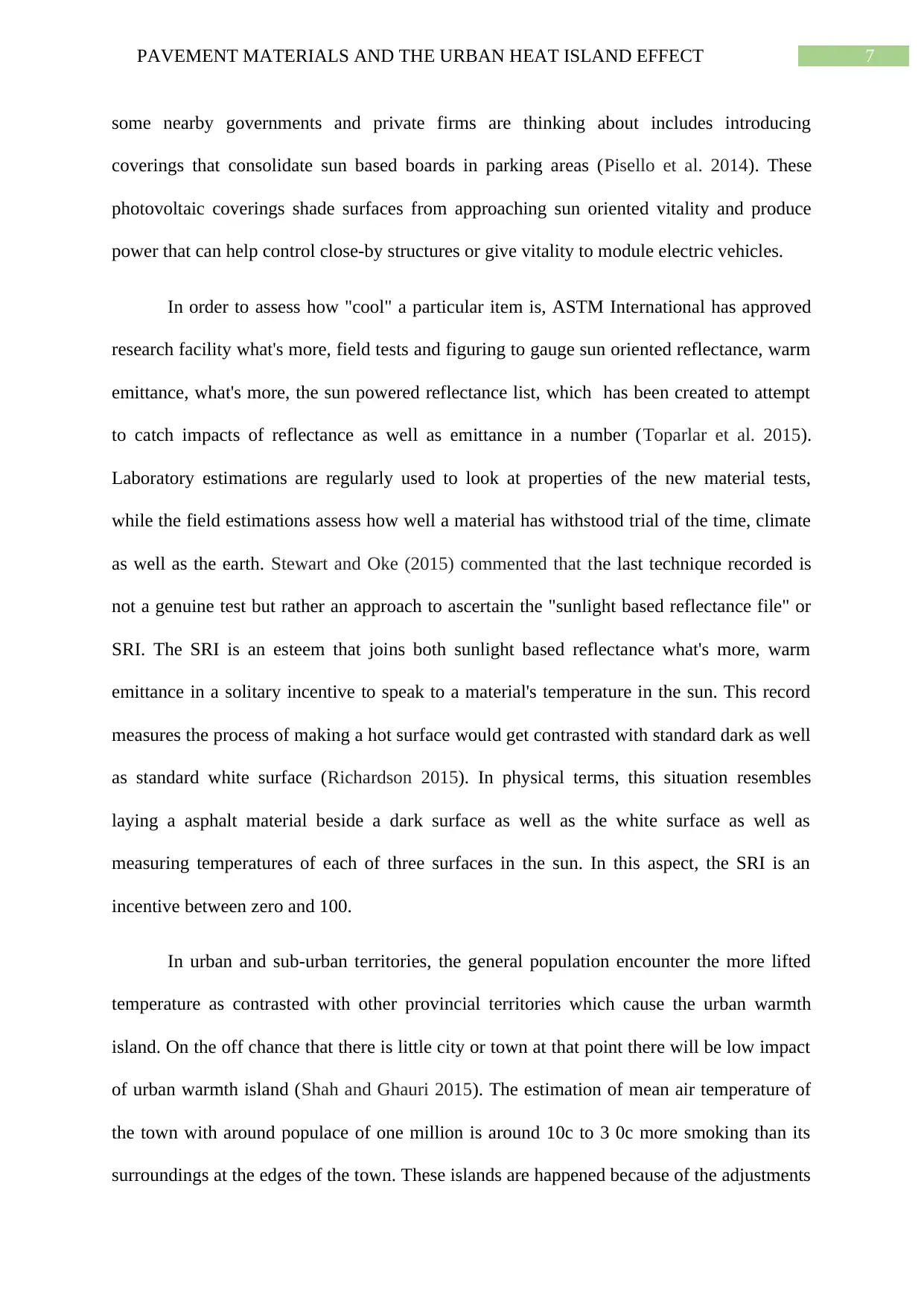
7PAVEMENT MATERIALS AND THE URBAN HEAT ISLAND EFFECT
some nearby governments and private firms are thinking about includes introducing
coverings that consolidate sun based boards in parking areas (Pisello et al. 2014). These
photovoltaic coverings shade surfaces from approaching sun oriented vitality and produce
power that can help control close-by structures or give vitality to module electric vehicles.
In order to assess how "cool" a particular item is, ASTM International has approved
research facility what's more, field tests and figuring to gauge sun oriented reflectance, warm
emittance, what's more, the sun powered reflectance list, which has been created to attempt
to catch impacts of reflectance as well as emittance in a number (Toparlar et al. 2015).
Laboratory estimations are regularly used to look at properties of the new material tests,
while the field estimations assess how well a material has withstood trial of the time, climate
as well as the earth. Stewart and Oke (2015) commented that the last technique recorded is
not a genuine test but rather an approach to ascertain the "sunlight based reflectance file" or
SRI. The SRI is an esteem that joins both sunlight based reflectance what's more, warm
emittance in a solitary incentive to speak to a material's temperature in the sun. This record
measures the process of making a hot surface would get contrasted with standard dark as well
as standard white surface (Richardson 2015). In physical terms, this situation resembles
laying a asphalt material beside a dark surface as well as the white surface as well as
measuring temperatures of each of three surfaces in the sun. In this aspect, the SRI is an
incentive between zero and 100.
In urban and sub-urban territories, the general population encounter the more lifted
temperature as contrasted with other provincial territories which cause the urban warmth
island. On the off chance that there is little city or town at that point there will be low impact
of urban warmth island (Shah and Ghauri 2015). The estimation of mean air temperature of
the town with around populace of one million is around 10c to 3 0c more smoking than its
surroundings at the edges of the town. These islands are happened because of the adjustments
some nearby governments and private firms are thinking about includes introducing
coverings that consolidate sun based boards in parking areas (Pisello et al. 2014). These
photovoltaic coverings shade surfaces from approaching sun oriented vitality and produce
power that can help control close-by structures or give vitality to module electric vehicles.
In order to assess how "cool" a particular item is, ASTM International has approved
research facility what's more, field tests and figuring to gauge sun oriented reflectance, warm
emittance, what's more, the sun powered reflectance list, which has been created to attempt
to catch impacts of reflectance as well as emittance in a number (Toparlar et al. 2015).
Laboratory estimations are regularly used to look at properties of the new material tests,
while the field estimations assess how well a material has withstood trial of the time, climate
as well as the earth. Stewart and Oke (2015) commented that the last technique recorded is
not a genuine test but rather an approach to ascertain the "sunlight based reflectance file" or
SRI. The SRI is an esteem that joins both sunlight based reflectance what's more, warm
emittance in a solitary incentive to speak to a material's temperature in the sun. This record
measures the process of making a hot surface would get contrasted with standard dark as well
as standard white surface (Richardson 2015). In physical terms, this situation resembles
laying a asphalt material beside a dark surface as well as the white surface as well as
measuring temperatures of each of three surfaces in the sun. In this aspect, the SRI is an
incentive between zero and 100.
In urban and sub-urban territories, the general population encounter the more lifted
temperature as contrasted with other provincial territories which cause the urban warmth
island. On the off chance that there is little city or town at that point there will be low impact
of urban warmth island (Shah and Ghauri 2015). The estimation of mean air temperature of
the town with around populace of one million is around 10c to 3 0c more smoking than its
surroundings at the edges of the town. These islands are happened because of the adjustments
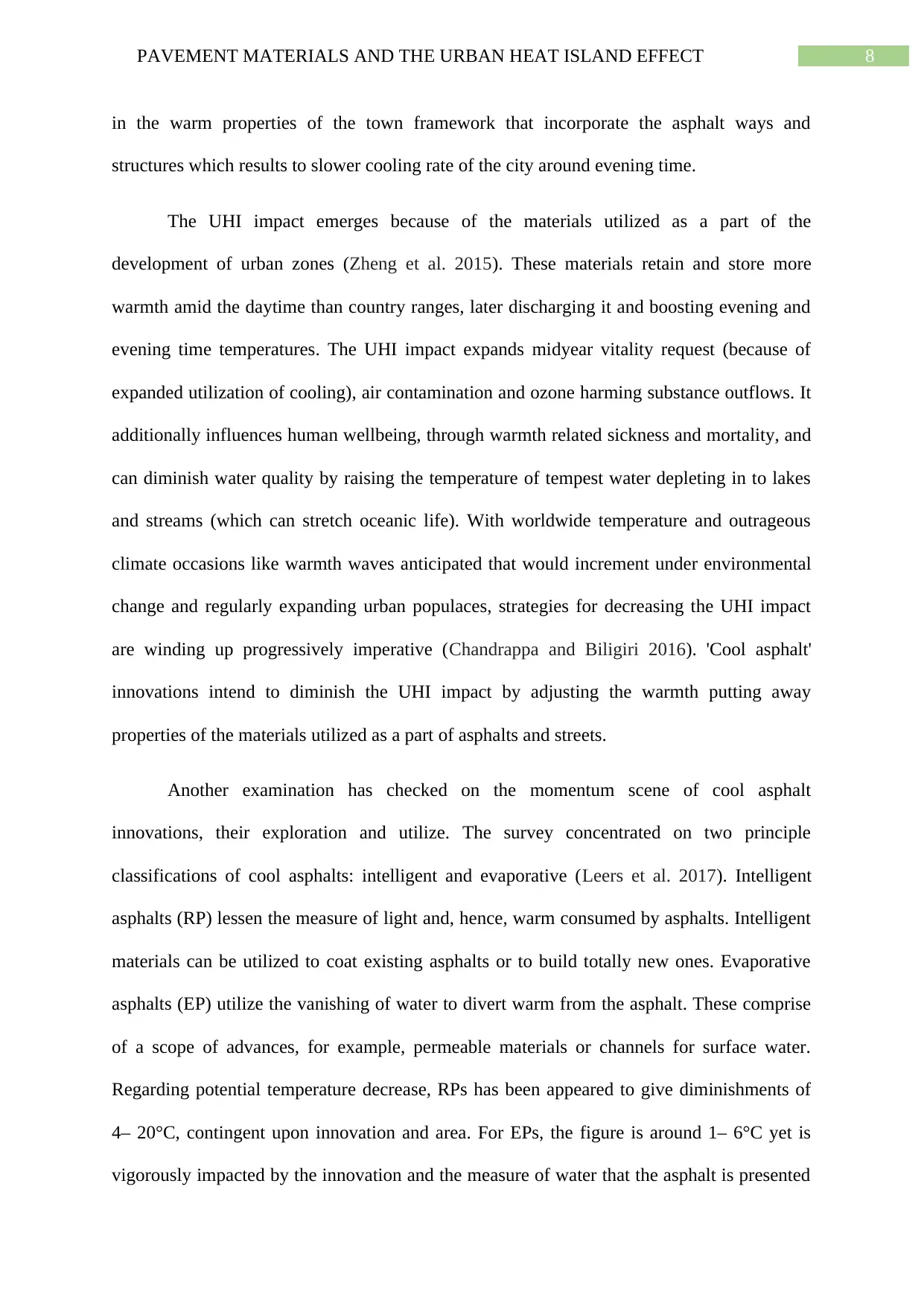
8PAVEMENT MATERIALS AND THE URBAN HEAT ISLAND EFFECT
in the warm properties of the town framework that incorporate the asphalt ways and
structures which results to slower cooling rate of the city around evening time.
The UHI impact emerges because of the materials utilized as a part of the
development of urban zones (Zheng et al. 2015). These materials retain and store more
warmth amid the daytime than country ranges, later discharging it and boosting evening and
evening time temperatures. The UHI impact expands midyear vitality request (because of
expanded utilization of cooling), air contamination and ozone harming substance outflows. It
additionally influences human wellbeing, through warmth related sickness and mortality, and
can diminish water quality by raising the temperature of tempest water depleting in to lakes
and streams (which can stretch oceanic life). With worldwide temperature and outrageous
climate occasions like warmth waves anticipated that would increment under environmental
change and regularly expanding urban populaces, strategies for decreasing the UHI impact
are winding up progressively imperative (Chandrappa and Biligiri 2016). 'Cool asphalt'
innovations intend to diminish the UHI impact by adjusting the warmth putting away
properties of the materials utilized as a part of asphalts and streets.
Another examination has checked on the momentum scene of cool asphalt
innovations, their exploration and utilize. The survey concentrated on two principle
classifications of cool asphalts: intelligent and evaporative (Leers et al. 2017). Intelligent
asphalts (RP) lessen the measure of light and, hence, warm consumed by asphalts. Intelligent
materials can be utilized to coat existing asphalts or to build totally new ones. Evaporative
asphalts (EP) utilize the vanishing of water to divert warm from the asphalt. These comprise
of a scope of advances, for example, permeable materials or channels for surface water.
Regarding potential temperature decrease, RPs has been appeared to give diminishments of
4– 20°C, contingent upon innovation and area. For EPs, the figure is around 1– 6°C yet is
vigorously impacted by the innovation and the measure of water that the asphalt is presented
in the warm properties of the town framework that incorporate the asphalt ways and
structures which results to slower cooling rate of the city around evening time.
The UHI impact emerges because of the materials utilized as a part of the
development of urban zones (Zheng et al. 2015). These materials retain and store more
warmth amid the daytime than country ranges, later discharging it and boosting evening and
evening time temperatures. The UHI impact expands midyear vitality request (because of
expanded utilization of cooling), air contamination and ozone harming substance outflows. It
additionally influences human wellbeing, through warmth related sickness and mortality, and
can diminish water quality by raising the temperature of tempest water depleting in to lakes
and streams (which can stretch oceanic life). With worldwide temperature and outrageous
climate occasions like warmth waves anticipated that would increment under environmental
change and regularly expanding urban populaces, strategies for decreasing the UHI impact
are winding up progressively imperative (Chandrappa and Biligiri 2016). 'Cool asphalt'
innovations intend to diminish the UHI impact by adjusting the warmth putting away
properties of the materials utilized as a part of asphalts and streets.
Another examination has checked on the momentum scene of cool asphalt
innovations, their exploration and utilize. The survey concentrated on two principle
classifications of cool asphalts: intelligent and evaporative (Leers et al. 2017). Intelligent
asphalts (RP) lessen the measure of light and, hence, warm consumed by asphalts. Intelligent
materials can be utilized to coat existing asphalts or to build totally new ones. Evaporative
asphalts (EP) utilize the vanishing of water to divert warm from the asphalt. These comprise
of a scope of advances, for example, permeable materials or channels for surface water.
Regarding potential temperature decrease, RPs has been appeared to give diminishments of
4– 20°C, contingent upon innovation and area. For EPs, the figure is around 1– 6°C yet is
vigorously impacted by the innovation and the measure of water that the asphalt is presented
⊘ This is a preview!⊘
Do you want full access?
Subscribe today to unlock all pages.

Trusted by 1+ million students worldwide

9PAVEMENT MATERIALS AND THE URBAN HEAT ISLAND EFFECT
to. For the most part, EPs are more useful for blustery or sticky conditions while RPs are
more suited to parched conditions (Roesler and Sen 2016). As far as strength and life span,
EPs might be less viable than RPs. The materials used to build evaporative advancements are
commonly less sturdy and their pores may wind up plainly stopped up after some time,
requiring upkeep and along these lines diminishing their productivity.
to. For the most part, EPs are more useful for blustery or sticky conditions while RPs are
more suited to parched conditions (Roesler and Sen 2016). As far as strength and life span,
EPs might be less viable than RPs. The materials used to build evaporative advancements are
commonly less sturdy and their pores may wind up plainly stopped up after some time,
requiring upkeep and along these lines diminishing their productivity.
Paraphrase This Document
Need a fresh take? Get an instant paraphrase of this document with our AI Paraphraser
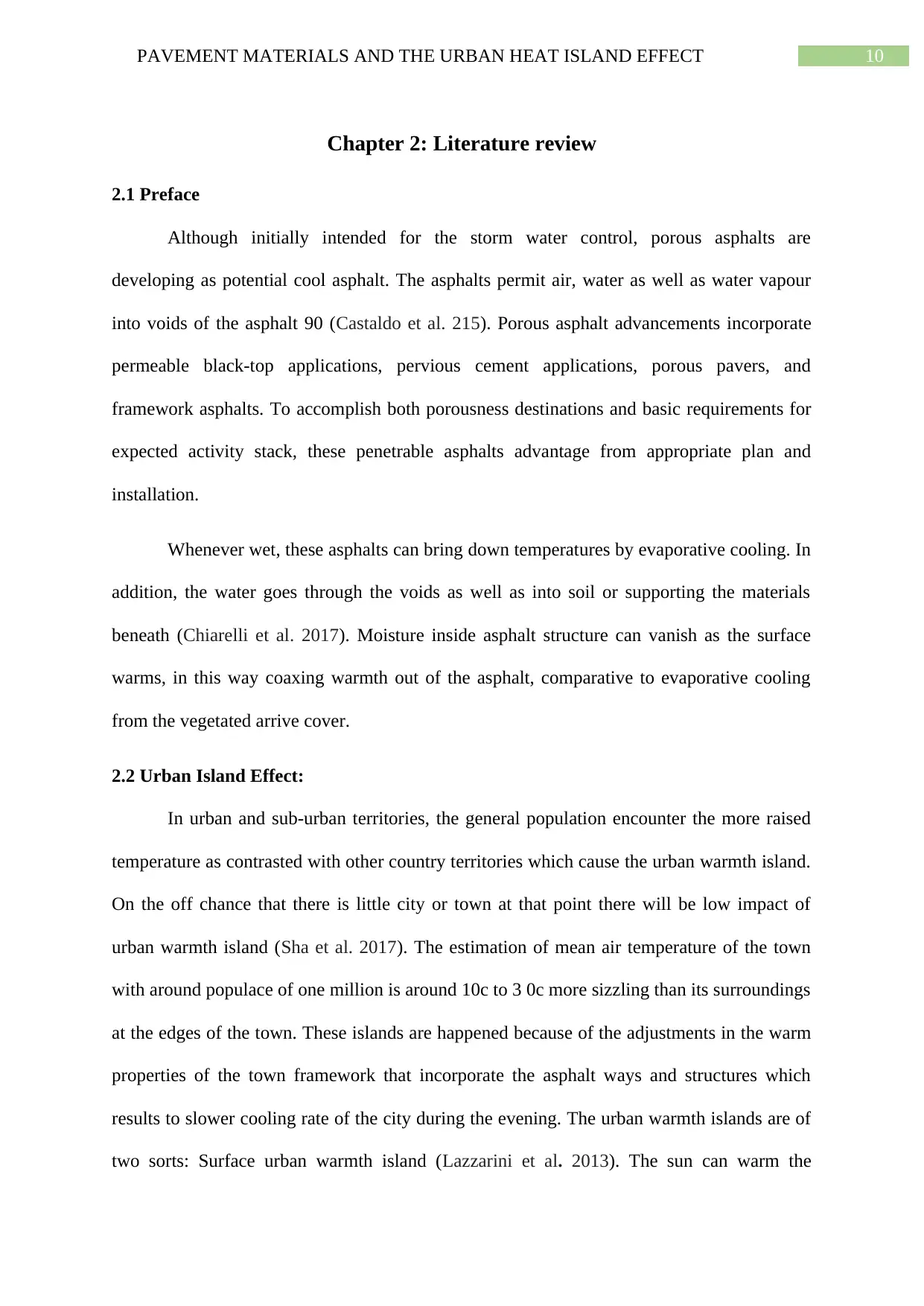
10PAVEMENT MATERIALS AND THE URBAN HEAT ISLAND EFFECT
Chapter 2: Literature review
2.1 Preface
Although initially intended for the storm water control, porous asphalts are
developing as potential cool asphalt. The asphalts permit air, water as well as water vapour
into voids of the asphalt 90 (Castaldo et al. 215). Porous asphalt advancements incorporate
permeable black-top applications, pervious cement applications, porous pavers, and
framework asphalts. To accomplish both porousness destinations and basic requirements for
expected activity stack, these penetrable asphalts advantage from appropriate plan and
installation.
Whenever wet, these asphalts can bring down temperatures by evaporative cooling. In
addition, the water goes through the voids as well as into soil or supporting the materials
beneath (Chiarelli et al. 2017). Moisture inside asphalt structure can vanish as the surface
warms, in this way coaxing warmth out of the asphalt, comparative to evaporative cooling
from the vegetated arrive cover.
2.2 Urban Island Effect:
In urban and sub-urban territories, the general population encounter the more raised
temperature as contrasted with other country territories which cause the urban warmth island.
On the off chance that there is little city or town at that point there will be low impact of
urban warmth island (Sha et al. 2017). The estimation of mean air temperature of the town
with around populace of one million is around 10c to 3 0c more sizzling than its surroundings
at the edges of the town. These islands are happened because of the adjustments in the warm
properties of the town framework that incorporate the asphalt ways and structures which
results to slower cooling rate of the city during the evening. The urban warmth islands are of
two sorts: Surface urban warmth island (Lazzarini et al. 2013). The sun can warm the
Chapter 2: Literature review
2.1 Preface
Although initially intended for the storm water control, porous asphalts are
developing as potential cool asphalt. The asphalts permit air, water as well as water vapour
into voids of the asphalt 90 (Castaldo et al. 215). Porous asphalt advancements incorporate
permeable black-top applications, pervious cement applications, porous pavers, and
framework asphalts. To accomplish both porousness destinations and basic requirements for
expected activity stack, these penetrable asphalts advantage from appropriate plan and
installation.
Whenever wet, these asphalts can bring down temperatures by evaporative cooling. In
addition, the water goes through the voids as well as into soil or supporting the materials
beneath (Chiarelli et al. 2017). Moisture inside asphalt structure can vanish as the surface
warms, in this way coaxing warmth out of the asphalt, comparative to evaporative cooling
from the vegetated arrive cover.
2.2 Urban Island Effect:
In urban and sub-urban territories, the general population encounter the more raised
temperature as contrasted with other country territories which cause the urban warmth island.
On the off chance that there is little city or town at that point there will be low impact of
urban warmth island (Sha et al. 2017). The estimation of mean air temperature of the town
with around populace of one million is around 10c to 3 0c more sizzling than its surroundings
at the edges of the town. These islands are happened because of the adjustments in the warm
properties of the town framework that incorporate the asphalt ways and structures which
results to slower cooling rate of the city during the evening. The urban warmth islands are of
two sorts: Surface urban warmth island (Lazzarini et al. 2013). The sun can warm the
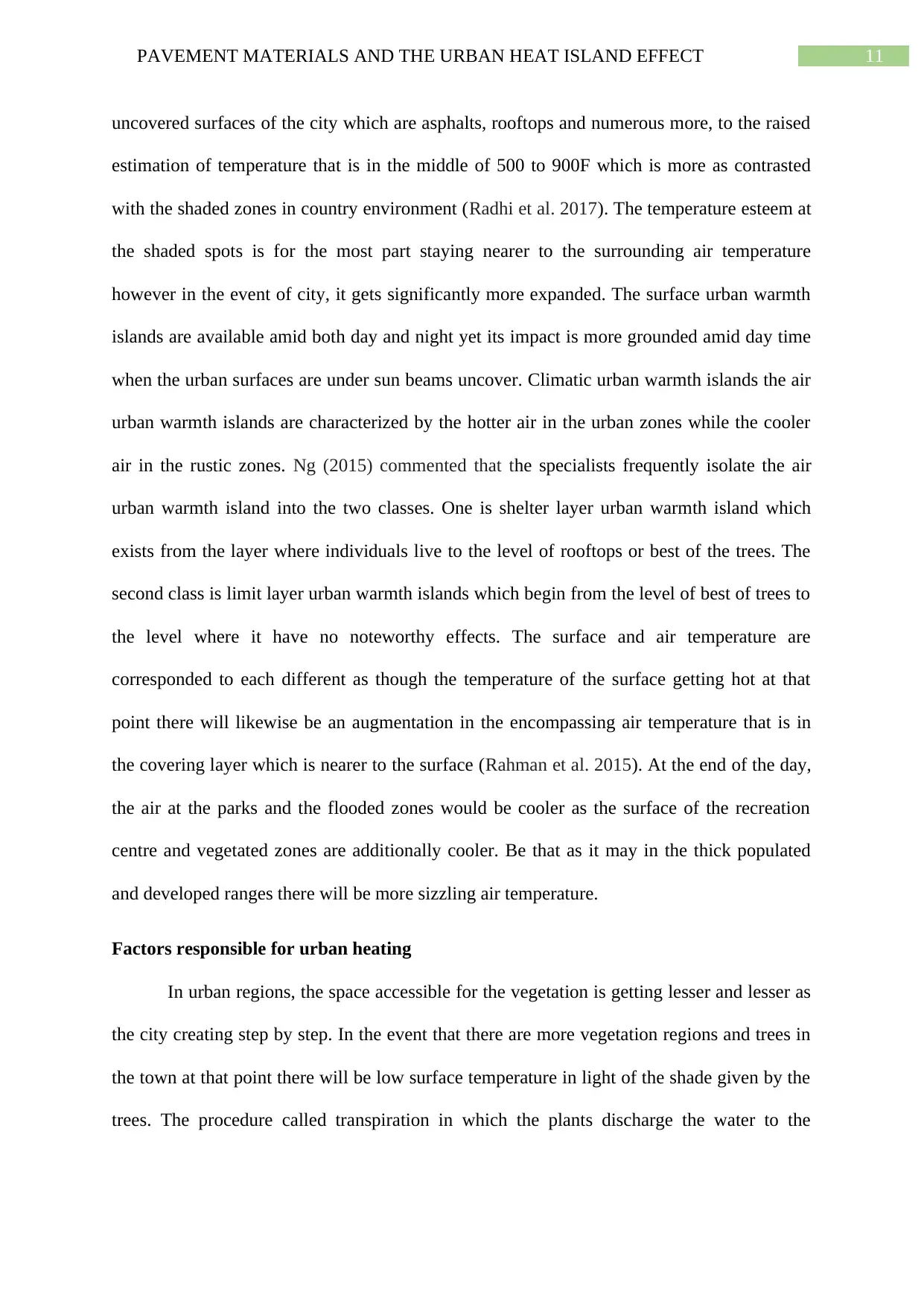
11PAVEMENT MATERIALS AND THE URBAN HEAT ISLAND EFFECT
uncovered surfaces of the city which are asphalts, rooftops and numerous more, to the raised
estimation of temperature that is in the middle of 500 to 900F which is more as contrasted
with the shaded zones in country environment (Radhi et al. 2017). The temperature esteem at
the shaded spots is for the most part staying nearer to the surrounding air temperature
however in the event of city, it gets significantly more expanded. The surface urban warmth
islands are available amid both day and night yet its impact is more grounded amid day time
when the urban surfaces are under sun beams uncover. Climatic urban warmth islands the air
urban warmth islands are characterized by the hotter air in the urban zones while the cooler
air in the rustic zones. Ng (2015) commented that the specialists frequently isolate the air
urban warmth island into the two classes. One is shelter layer urban warmth island which
exists from the layer where individuals live to the level of rooftops or best of the trees. The
second class is limit layer urban warmth islands which begin from the level of best of trees to
the level where it have no noteworthy effects. The surface and air temperature are
corresponded to each different as though the temperature of the surface getting hot at that
point there will likewise be an augmentation in the encompassing air temperature that is in
the covering layer which is nearer to the surface (Rahman et al. 2015). At the end of the day,
the air at the parks and the flooded zones would be cooler as the surface of the recreation
centre and vegetated zones are additionally cooler. Be that as it may in the thick populated
and developed ranges there will be more sizzling air temperature.
Factors responsible for urban heating
In urban regions, the space accessible for the vegetation is getting lesser and lesser as
the city creating step by step. In the event that there are more vegetation regions and trees in
the town at that point there will be low surface temperature in light of the shade given by the
trees. The procedure called transpiration in which the plants discharge the water to the
uncovered surfaces of the city which are asphalts, rooftops and numerous more, to the raised
estimation of temperature that is in the middle of 500 to 900F which is more as contrasted
with the shaded zones in country environment (Radhi et al. 2017). The temperature esteem at
the shaded spots is for the most part staying nearer to the surrounding air temperature
however in the event of city, it gets significantly more expanded. The surface urban warmth
islands are available amid both day and night yet its impact is more grounded amid day time
when the urban surfaces are under sun beams uncover. Climatic urban warmth islands the air
urban warmth islands are characterized by the hotter air in the urban zones while the cooler
air in the rustic zones. Ng (2015) commented that the specialists frequently isolate the air
urban warmth island into the two classes. One is shelter layer urban warmth island which
exists from the layer where individuals live to the level of rooftops or best of the trees. The
second class is limit layer urban warmth islands which begin from the level of best of trees to
the level where it have no noteworthy effects. The surface and air temperature are
corresponded to each different as though the temperature of the surface getting hot at that
point there will likewise be an augmentation in the encompassing air temperature that is in
the covering layer which is nearer to the surface (Rahman et al. 2015). At the end of the day,
the air at the parks and the flooded zones would be cooler as the surface of the recreation
centre and vegetated zones are additionally cooler. Be that as it may in the thick populated
and developed ranges there will be more sizzling air temperature.
Factors responsible for urban heating
In urban regions, the space accessible for the vegetation is getting lesser and lesser as
the city creating step by step. In the event that there are more vegetation regions and trees in
the town at that point there will be low surface temperature in light of the shade given by the
trees. The procedure called transpiration in which the plants discharge the water to the
⊘ This is a preview!⊘
Do you want full access?
Subscribe today to unlock all pages.

Trusted by 1+ million students worldwide
1 out of 44
Related Documents
Your All-in-One AI-Powered Toolkit for Academic Success.
+13062052269
info@desklib.com
Available 24*7 on WhatsApp / Email
![[object Object]](/_next/static/media/star-bottom.7253800d.svg)
Unlock your academic potential
Copyright © 2020–2025 A2Z Services. All Rights Reserved. Developed and managed by ZUCOL.





